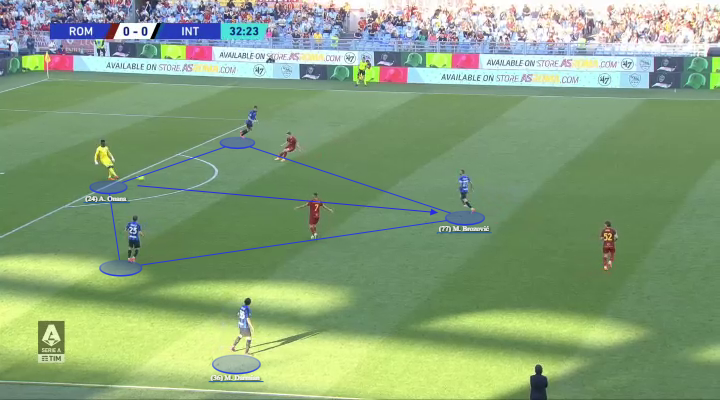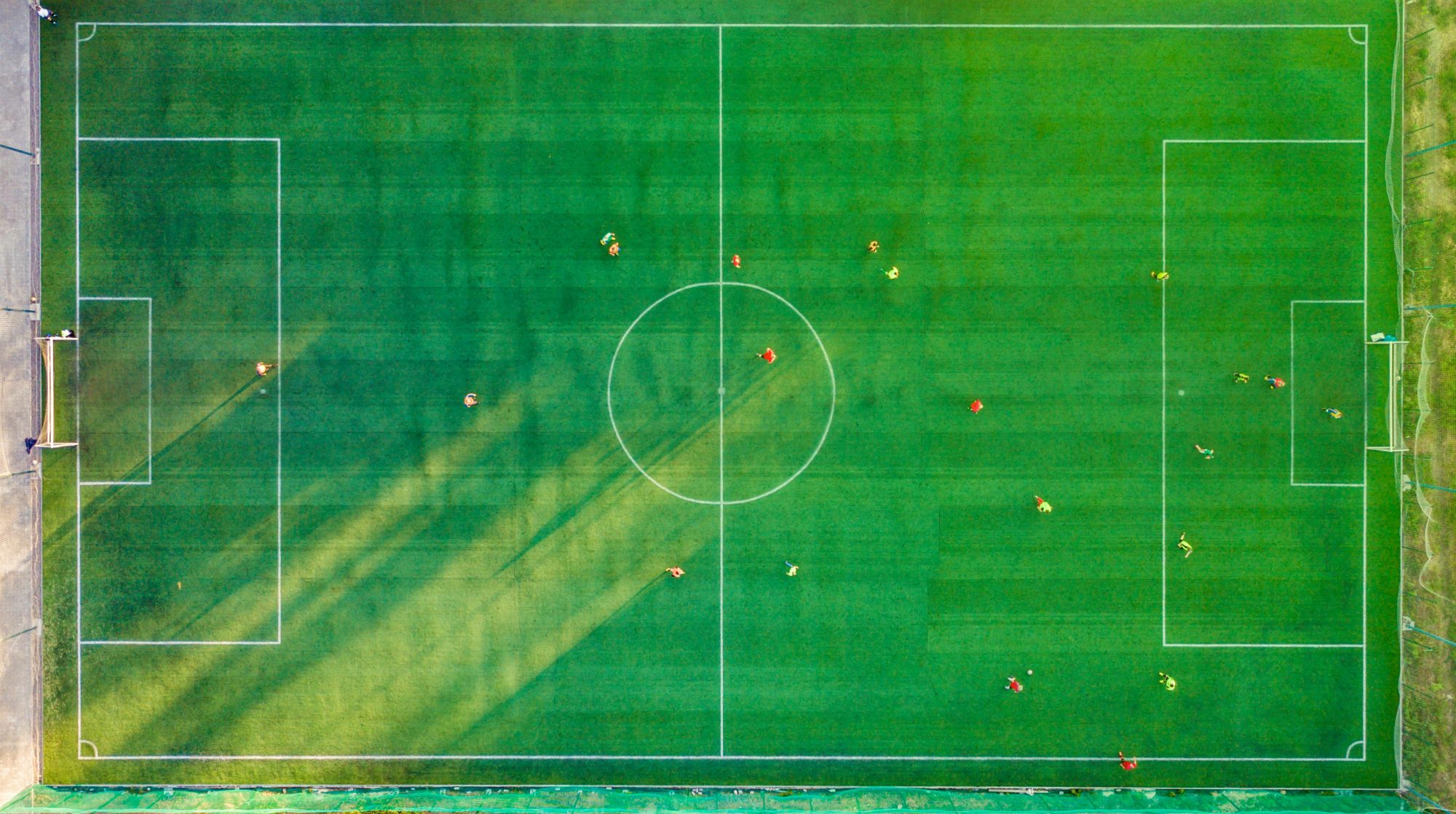While it’s true that one of Inter Milan’s main goals will be to win Serie A again, there’s no denying that this has been a phenomenal season for the Italian giants. They’ve flourished under Simone Inzaghi thanks to a clear identity and several succinct principles of play, much of which have remained in place since the days of Antonio Conte. I Nerazzurri now prepare for the crowning moment in the Coppa Italia and the UEFA Champions League Final, serving as the perfect time to break down Simone Inzaghi’s incredible Inter Milan. Here is our tactical analysis of the Black and Blues in 2022-23.
SYSTEM OF PLAY: 3-5-2

Inter’s principles have stayed incredibly consistent since the days of Antonio Conte, including the use of a 3-5-2 formation. Many of those characters fazed out since Conte’s reign, but a few constants remain. That includes the heroic Lautaro Martinez up front, who still remains at Inter despite links to a host of clubs over the years. Romelu Lukaku and 37-year-old Edin Džeko continue to battle for the place alongside Martinez, with both acting as the perfect ‘Target’ for Martinez to play the foil. Inzaghi then brought Joaquin Correa with him from Lazio, providing a capable understudy to the team captain anytime a rest feels necessary.
Embed from Getty ImagesNicolò Barella also remains a key part of the attack as he makes his late-arriving runs from midfield, and has a brilliant understanding with Martinez. Marcelo Brozović meanwhile continues to be a key cog in midfield, but has been usurped on occasion by former ‘number 10’ Hakan Çalhanoğlu. Playing the Turk as a ‘6’ has allowed Inzaghi to find room for the rampaging Henrikh Mkhitaryan to add some extra attacking flair, as the Armenian has come to life at the right time.
Embed from Getty ImagesWing-backs have seen some changes from the days of Achraf Hakimi and Ivan Perišić, and Inzaghi now has a rotation of players fighting for the places. His preference has skewed toward the clever Federico Dimarco and the dynamic Denzel Dumfries in recent matches, who have 17 goal contributions between the two of them in league and Champions League play.
Embed from Getty ImagesAt the back, Inzaghi again has a plethora of fantastic options. Alessandro Bastoni is the best on the ball, smoothly carrying into space and progressing the play into the strikers without any issue. Francesco Acerbi has become the favourite of the ‘Sweepers’ to play in the middle of Inzaghi’s back-three, but he still has to contend with Dutchman Stefan De Vrij, who’s made that role his own the past few seasons. Acerbi combines physicality, positional awareness and leadership to emerge as the favourite, despite this being just a one-season loan from Lazio for the time being.
Embed from Getty ImagesThen there’s Matteo Darmian, someone who can fulfill a number of roles, but excels as the right-sided centre-back due to his mobility and 1v1 duelling success. Milan Skriniar has been the unfortunate man to some of this season due to injury, but I Nerazzurri have hardly missed a beat without him.
Embed from Getty ImagesIn goal, the gloves have finally changed hands from 38-year-old club captain Samir Handanović, who’s held down his position since 2012. André Onana‘s finally earned his big move from Ajax, and has been great at all the passing out from the back that Inzaghi wants from his keeper.
Embed from Getty ImagesThe functionality of Inter’s shape is something that then has little disruption regardless of who enters the fold. Without Martinez, Barella or Bastoni, some slight tweaks might be necessary, but the Black & Blues have a capable understudy in every single position, and never have to drastically change their tactics from one match to another. So with that, let’s jump into exactly what those tactics are, and how they’re able to be so consistent within their principles of play.
DEFENSIVE PRINCIPLES
Embed from Getty ImagesTo play at Inter Milan, it’s almost a requirement to love the defensive side of the game. You have to be a combative warrior – someone that is utterly unwilling to back down from a fight. So even though they’ve upped their possession to 56.6% this season and have completely taken control of many matches, defending is still something they hold near and dear to their hearts.
Embed from Getty ImagesWhen it comes to the defensive side of the game, they are relatively flexible in adjusting to the movement of the opposition. They will keep certain principles in-tact, with their front two and back-three generally holding fixed positions. But as the pendulum swings side to side, you may see different players jumping all the way up to the front of the block. Most frequently, that will be the near-side central midfielder, where Mkhitaryan or Barella jump to track deeper opposition players, or to follow their man toward the ball. The defensive midfielder will generally hold a more reserved position as they look to screen the opposition’s striker.
But when the ball reaches one side of the field, you can also expect the ‘6’ to be higher than the far-sided central midfielder. This is a cool conveyor belt within their midfield three, where they provide an angled defense to first stop near-sided attacks, and force the opposition to switch play, where they can then swing the pendulum the other way.

From moments like this, it not only becomes difficult to switch play, but dangerous. The far-sided central player holds such a strong position, that they could easily step up to intercept the pass and allow the Black & Blues to immediately go on the hunt.
This is completely rooted into their principles of play, as I Nerazzurri will adopt this angled approach from their high-block all the way to their low-block.

It’s part of that overarching pendulum swing that Inter accomplish magnificently well, giving near-sided players the freedom to step, as far-sided players hold a more reserved stance.
So while I mentioned their back-three generally remain in-tact in defensive phases, the outside centre-backs also have freedom to step up when needed. Support always remains in behind with the ‘6’ and ‘Sweeper’ holding rank, not to mention the far-sided centre-back to form a back-four. So if the wing-backs then hold position too, you can see moments where Darmian or Bastoni step all the way forward to track an opposition forward.

Super-talented opposition sides will use moments like this to cause disruptions and disconnections in the back-line that can then be exploited by other runners. But with that back-four holding strong and shortening the distance between themselves and the goal to limit passes over the top, it’s difficult to then use rotation to break down Inzaghi’s side.
The same kind of idea applies to their wing-backs. They might exist as part of a back-five until the ball starts to approach either their side or a player in front of their zone. They then amplify their pressure and race all the way up, as the other one drops back or holds a reserved role. If the opposition are then successful in switching play, you can see that wing-back move backward.

The advantage to this kind of defensive swing is that it always maintains a tremendous defensive balance, while limiting the opposition’s ability to progress up the wing. Then as mentioned, you can’t really switch play. The far-sided players remain ready to engage, not to mention the stern midfield three holding compaction in the centre of the pitch.

So if you’re an opposition team, you’re then looking for moments to catch them in transition, or when you can pull players out of position with quick and incisive passing/movement. The first goal they conceded against Benfica in their 3-3 draw is a great example, demonstrating the ripple effect that can occur if one player gets caught out of position.
In this case, it was Federico Dimarco who found himself away from his back-line, causing Alessandro Bastoni to shift over and stop the cross. Matteo Darmian then had to come across to cover the vacant gap, leaving another gap between himself and his wing-back, where the Benfica player was able to score.
Embed from Getty ImagesThis is how you can hurt the Italian giants, but it’s incredibly rare to catch them in one of these moments. If you try and make the game more transitional, that’s also a dangerous preposition. Inter thrive off counter-attacks, and even excel in quickly stopping fast breaks the other way. That’s not through a fervid counter-press. In fact, Inter are perfectly fine with letting their opposition have the ball at the back end of the pitch.
Instead, it’s through a quick reshuffle of players back into the deck of where they’re supposed to be. Mobility is a major requirement of players in the wing-back and central midfield positions, which is perhaps one more reason for Çalhanoğlu’s positional switch, where he can instead thrive with his intelligent reading of the game. With all the bodies they have through the centre of the pitch, you’d typically have to counter through the wings, which is already further away from goal, and gives central players time to catch up.
When they are then able to get back into the box in numbers, it’s tough to find the right crossing angles.

Despite this defensive solidity, the club have had somewhat of a problem keeping clean sheets this season. But when they adopt more of a defensive approach, they completely batter their opposition into oblivion. This has been particularly successful in the two semi-final matches against AC Milan, where they relinquished possession and then bruised AC Milan on the break to suit their strengths. Remind you of a past Inter Milan side? Yeah, when they play that Conte-esque way, it’s incredibly difficult to break I Nerazzurri down. That much hasn’t changed one bit, and Inzaghi deserves credit not only for his defensive organization, but for the additions and positional tweaks he’s made to solidify his defensive approach.
ATTACKING PRINCIPLES

Even with that defensive resilience, Inzaghi’s men are from a defensive side. You can expect them to adopt more of that defensive mindset in the Champions League final against Manchester City, but don’t be surprised to see them dictating the tempo of the Coppa Italia final against Fiorentina.
Embed from Getty ImagesInzaghi’s side have thrived this season in possession, through much of the ways you’d expect of both an Inter side, and a side playing in a 3-5-2. Their outside centre-backs carry the ball into space when available, play nice progressive passes into their strikers, and the strikers break away quickly in transition, where they are then immediately joined by the wing-backs and central midfielders to compound matters. Sounds very Inter!

One thing that I admire is the general lack of positional rotation or “positional play” within this Inter side. It’s not like a Pep side where players are constantly adjusting for the positioning of their teammates. It’s actually quite rigid and more of what you’d expect from the term “positional play” if you didn’t know the meaning – a side that stays in concrete positions for most of the match.

Perhaps the two players that are most adventurous in their approach away from normality are Alessandro Bastoni and Nicolò Barella. Like any good pendulum, Bastoni brilliantly perceives moments to step up in the left-half-spaces, while Barella brilliantly perceives moments to race up in the right-half-spaces. But it’s less of a pendulum and more of a synchronized dance, where both players can move up in tandem. As Bastoni attracts the pressure toward himself, space is bound to open on the other side for Barella to race in behind. This is where they scored a brilliant goal in the second-leg against Benfica.

Few centre-backs have impressed me more this season than Bastoni. As I get ready to release a post on the best ‘Ball-Playing Centre-Halves’ this season, prepare for Bastoni to spike highest in some of the progressive numbers. As things stand, he ranks second in progressive passes (11.3) and progressive carries (2.1) of players fighting for the ‘Top 20’. This has been a critical feature to the way Inter play, with Bastoni wonderfully selecting the moments to take advantage of space ahead.
He’s not afraid to overlap his wing-back, where he can then draw attention away from strikers and allow for passes into the penalty area.

Joaquin Correa’s goal against Benfica came from this exact harmonized movement, with Dimarco finding room to play the pass over to Correa thanks to Bastoni’s deceptive overlap.
Speaking of Dimarco, he’s been absolutely immense in Inter’s Champions League rise. He’s accumulated 5 assists in 10 Champions League matches this campaign, in just his second season as an Inter regular. He provides a true sense of cleverness in the final third, and often provides early crosses into the box to expose high-lines and take advantage of quick counter attacks.

Denzel Dumfries down the other side is more toe-to-toe as he gallops down the right wing and looks to race into the penalty area. But as a feature of any good side playing with wing-backs, don’t be surprised to see one wing-back crossing to the other to score.

They’re deadly on the break through the speed at which their wing-backs attack, immediately springing forward to create a six-player attacking unit of four players through the middle and two on the outside. As the likes of Barella and Dumfries attract attention and pull defenders toward one side, space opens for that far-sided central midfielder and wing-back to take advantage.

But out of all their players, it’s Lautaro Martinez who you want on the ball at every turn on the break. He’s often combining nicely with the ‘Target’ beside him, and superb at reading the surging runs of Nicolò Barella. He’s an exceptional carrier of the ball, often drawing the opposition into silly fouls. But the Argentinean forward is also an underrated creator, often dropping into gaps to find space and then play forward.
With the hold-up play of either Edin Džeko or Romelu Lukaku alongside him, his mobility and ball control makes for the perfect partner to play up top alongside that more robust figurehead. Inter also happen to be excellent at playing to the strengths of their forwards.
Their midfield men will often move closer to the ball during progression phases, opening up more space for the likes of Lukaku and Martinez to receive. Bastoni is great at playing passes over the top of defenses into their path, and they even utilize that pendulum swing to their advantage in attack.

As the near-side wing-back will often come closer to the ball when Inter build out from the back, they will then attract attention with them. This opens space for progressive passes into the likes of Lukaku, who can be deadly when they’re able to pin a defender back.
Since this is Serie A, you can also expect Inter Milan to have a few intricate and meticulous build-up configurations. Out from the back, they will often form a diamond shape with their goalkeeper and defensive midfielder engaged. That’s normal of most possession-based teams these days. But what Inter often do differently is they push one outside centre-back higher, with the other maintaining that reserved stance in the diamond. More pendulum swinging!

They don’t even have to use that advanced outside centre-back. In fact it’s primary aim is to lure attention away from other players. Marcelo Brozović is brilliant when he has space and time to turn, and you can then push the wing-backs just about as high and wide as you want.
So by having another player position themselves down that side, Inter take the attention away from those high-flying wing-backs. Alternatively, they can inject some variety as the middle centre-back positions themselves higher, opening up more corridors to play through the middle.

When they break free, you can again expect quick passes to be played over the top to the strikers, or powerful carrying from the likes of Martinez and Barella.
They’re so rampant and so clinical when going forward that you almost don’t want to attack them and open your team up for further harm. This is something Manchester City will be looking into ahead of their Champions League final encounter, ensuring they have the appropriate rest-defense in place to combat the likes of Barella and Martinez going forward.
CONCLUSION
Embed from Getty ImagesInter Milan have had another wonderful season under Simone Inzaghi, and are now preparing for two finals as the season comes to a close. No one would have picked them to be in the Champions League Final this year, and if they get their tactics right and play to their strengths, they have all the potential in the world to beat Manchester City. Either way, this will be a season to remember for I Nerazzurri, and one that only further solidifies Inzaghi as a brilliant tactician.
Embed from Getty Images
So there it is! A detailed analysis of Inter Milan in 2022-23 under Simone Inzaghi. Be sure to check out more of our Team Analyses, and follow on social media @desmondrhys. If you enjoy this kind of content, also consider joining our Patreon community to help support the site, and gain exclusive access to more tactical analyses. Thanks for reading and see you soon!
GET IN TOUCH WITH RHYS & LEARN MORE ABOUT TMS!

I am currently accepting new clients in my coaching & mentorship program. I work with coaches and players from around the world! If you’re interested in learning more about my site or experiencing my coaching, feel free to reach out! 👊⚽
rhys desmond – founder of themastermindsite
Across the past decade, I have worked with thousands of players and coaches across multiple sports and disciplines. I recognize the value of diving deeper beyond the first glance, and uncovering the deeper-lying ways to enhance performance. I make a commitment toward positive reinforcement, research-backed insights, and making the experience fun for those that work with me.
YOU MIGHT ALSO ENJOY…
Why Jesse Marsch is perfect for the Canadian Men’s National Team
The American coach made his name across an incredibly successful spell at RB Salzburg between 2019-2021, but hasn’t been able to hold down the fort since. His brief stints at RB Leipzig and Leeds United showed signs of promise, but also many moments of doubt. So with Marsch being out of a top-tier job for…
Pep Guardiola – Manchester City – Tactical Analysis (2023-24)
This might finally be the year. It might finally be the year that Pep Guardiola and Manchester City don’t win the Premier League. Despite that, they’ve still been the most tactically complex team in the league, carrying on from much of the tactics that brought them a treble-winning triumph last season. Here is what Pep…
Game of Numbers #38 – Alejandro Garnacho’s intensity & awareness
It’s amazing to think that Alejandro Garnacho is only 19 years of age. Sometimes, you can see the rawness in his game. The facets that still need to be carefully developed. But as he ages, let’s hope he never loses his tenacity. His hunger for more. His appetite to win at all costs, even when…





2 thoughts on “Simone Inzaghi – Inter Milan – Tactical Analysis (2022-23)”